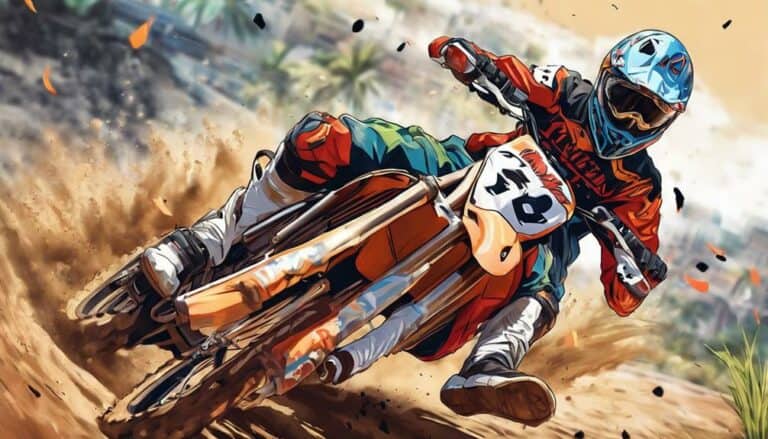When it comes to mastering the art of revving without moving your dirt bike, think of it as finding the balance between power and control, akin to a delicate dance between skill and finesse.
The ability to command the engine's roar while keeping your bike stationary opens up a universe of possibilities, enhancing your proficiency and understanding of your machine.
Stay tuned to discover the nuanced techniques and expert insights that can elevate your dirt biking experience to new heights.
Key Takeaways
- Adjust idle speed and use clutch for stationary revving.
- Maintain steady throttle hand to prevent movement.
- Practice throttle control for engine health and performance.
- Mastering revving in place enhances riding control and experience.
Benefits of Revving in Place
Revving in place offers significant advantages for off-road riders, enhancing engine performance and readiness without requiring movement. By engaging the throttle and reaching the rev limiter while stationary, you make sure that the engine is kept at a perfect temperature, preventing stalling in challenging off-road situations. This technique primes the engine for immediate acceleration when needed, giving you an edge in quick maneuvers. Additionally, revving in place aids in clearing out any debris or water that may have accumulated in the exhaust system, ensuring smooth operation when you hit the trails.
Additionally, practicing revving in place allows you to fine-tune throttle control and familiarize yourself with the bike's power delivery. Testing throttle response and adjusting idle settings without having to ride the bike provides a controlled environment for honing these skills. This level of precision and control can make a significant difference in your off-road riding experience, giving you the confidence to navigate diverse terrains with ease.
Techniques for Revving Stationary
To maintain control and rev your dirt bike in place without moving, make sure you practice proper throttle control techniques.
Start by adjusting the idle speed to a higher setting, allowing easier revving without engaging the clutch. Keep the bike in neutral to guarantee accidental movement.
When revving, use the clutch to keep the bike stationary while smoothly increasing and decreasing throttle. Guarantee your spark plug is in good condition, as a faulty one can affect your revving abilities.
Utilize a steady hand on the throttle to maintain a consistent engine speed. Remember, precise throttle control is key to revving without moving.
Importance of Proper Revving
Properly executing revving techniques is important for optimizing engine performance and responsiveness. When you rev your dirt bike correctly, you guarantee that all the engine parts are well-lubricated and ready for action. This can help prevent premature wear and tear on crucial components, ultimately extending the life of your bike. Additionally, revving without moving allows you to assess the throttle response of your bike, ensuring that it is sharp and precise.
To give you a clearer picture, let's break down the importance of proper revving into a table:
| Aspect | Importance |
|---|---|
| Engine Parts | Proper revving guarantees lubrication and longevity of engine components. |
| Throttle Response | Revving helps check and maintain sharp and accurate throttle response. |
| Power Band | Understanding revving helps you stay within the ideal power band for performance. |
Common Mistakes When Revving
Shifting from the importance of proper revving, it's essential to be mindful of common mistakes that can detrimentally impact your dirt bike's engine performance and longevity.
Revving too aggressively over the long term can cause severe engine damage, leading to costly repairs. When you rev without pulling the clutch or load on the engine, internal components suffer unnecessary wear and tear, affecting overall performance.
Failing to follow proper warm-up procedures before revving can harm the engine by not allowing the oil to reach best operating temperature, increasing the risk of damage. Not understanding the power band of your engine can result in suboptimal performance, limiting your riding experience.
Continuously revving without letting the engine cool down can lead to overheating issues, compromising the engine's durability. To ascertain your bike's longevity and performance, avoid these common revving mistakes and ride the bike responsibly.
Advanced Tips for Revving Practice
For enhanced control and precision in revving practice without moving your dirt bike, focus on mastering throttle manipulation techniques.
- Make sure to practice using the throttle with gradual pressure to control engine revs without moving.
- Dirt Bike Focus on maintaining a steady hand position and consistent throttle control to rev in place effectively.
- Need to test Experiment with different throttle inputs to understand how they affect the engine's revving without moving.
- Make sure to use your ears to gauge the engine sound and adjust the throttle accordingly for stationary revving.
- Dirt Bike Remember to keep safety in mind and ensure the bike is stable and secure while practicing revving without moving.
Conclusion
In summary, practicing stationary revving on your dirt bike can help improve throttle control and responsiveness.
Remember to rev gently, keeping the clutch engaged to prevent unnecessary strain on the engine components.
Prioritizing safety and proper maintenance is essential for best performance.
Avoid common mistakes and follow advanced tips to enhance your revving skills.
Stay steady, stay safe, and soar smoothly with your stationary revving sessions.

